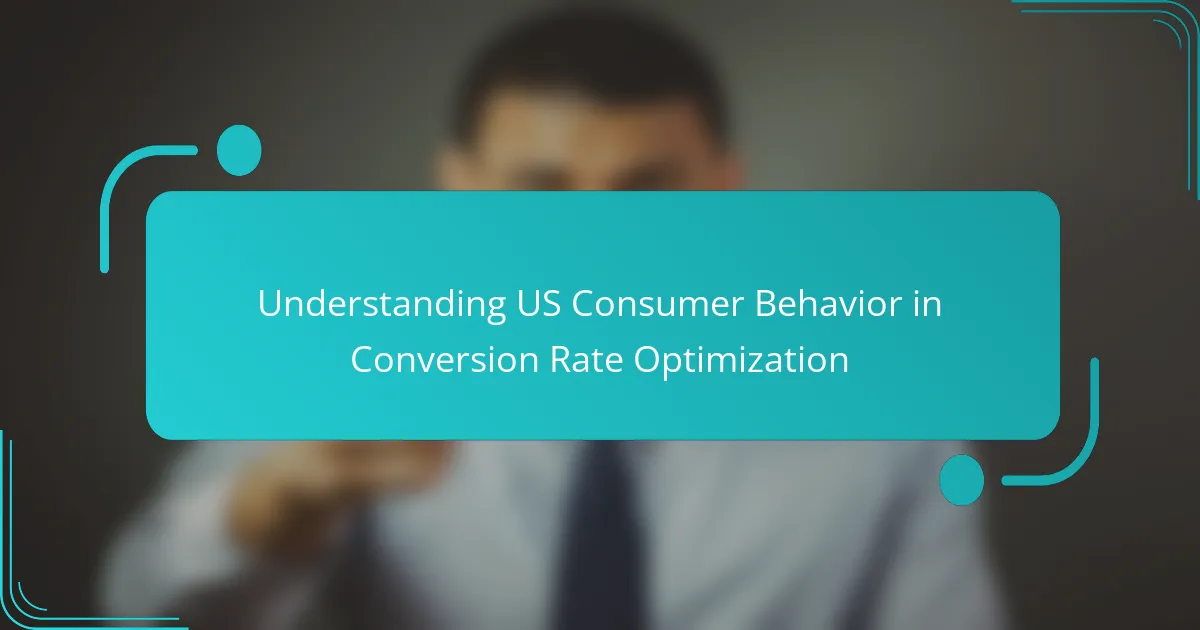Understanding US consumer behavior is essential for effective conversion rate optimization, as it involves recognizing key factors such as psychological triggers, social proof, and user experience design. By aligning marketing strategies with consumer expectations, businesses can significantly enhance their conversion rates through targeted approaches like A/B testing and website speed optimization. Trust also plays a pivotal role, as consumers are more inclined to engage with brands they perceive as reliable and secure.

What are the key factors influencing US consumer behavior in conversion rate optimization?
Key factors influencing US consumer behavior in conversion rate optimization include psychological triggers, social proof, user experience design, personalization strategies, and mobile optimization. Understanding these elements can significantly enhance conversion rates by aligning marketing strategies with consumer expectations and behaviors.
Psychological triggers
Psychological triggers are stimuli that influence consumer decisions, often operating at a subconscious level. Techniques such as scarcity (limited-time offers) and urgency (countdown timers) can compel consumers to act quickly. For instance, displaying a message like “Only 3 left in stock!” can create a sense of urgency that drives purchases.
Additionally, using emotional appeals, such as storytelling or relatable scenarios, can resonate with consumers, making them more likely to engage with a brand. Marketers should consider how these triggers can be integrated into their messaging to enhance conversion rates.
Social proof
Social proof refers to the influence that the actions and opinions of others have on an individual’s behavior. In the US, consumers often look for validation through reviews, testimonials, and user-generated content before making a purchase. Highlighting positive reviews or showcasing customer stories can build trust and encourage new customers to convert.
Incorporating elements like star ratings, customer testimonials, and case studies on product pages can effectively leverage social proof. Brands should actively encourage satisfied customers to leave reviews, as this can significantly impact potential buyers’ decisions.
User experience design
User experience (UX) design plays a crucial role in conversion rate optimization by ensuring that websites are intuitive and easy to navigate. A well-structured layout, clear calls to action, and fast loading times contribute to a positive user experience. For example, simplifying the checkout process can reduce cart abandonment rates.
It’s essential to conduct usability testing to identify pain points in the user journey. Regularly updating and optimizing the website based on user feedback can help maintain a high level of user satisfaction and increase conversion rates.
Personalization strategies
Personalization strategies involve tailoring content and experiences to individual consumer preferences and behaviors. In the US market, personalized product recommendations based on browsing history or previous purchases can significantly enhance engagement and conversion rates. For instance, an e-commerce site might display “Recommended for You” sections to guide users toward relevant products.
Utilizing data analytics to segment audiences and deliver targeted messaging can improve the effectiveness of marketing campaigns. Brands should focus on creating personalized experiences that resonate with their audience, leading to higher conversion rates.
Mobile optimization
Mobile optimization is critical as a significant portion of US consumers shop using mobile devices. Ensuring that websites are mobile-friendly involves responsive design, fast loading times, and easy navigation. A seamless mobile experience can lead to higher engagement and conversion rates, as users are more likely to complete purchases on devices they frequently use.
Brands should implement mobile-specific features, such as one-click purchasing and simplified forms, to enhance the mobile shopping experience. Regularly testing mobile usability can help identify areas for improvement and ensure that the mobile experience meets consumer expectations.

How can businesses improve conversion rates in the US market?
Businesses can enhance conversion rates in the US market by implementing targeted strategies that focus on user experience, data-driven decisions, and effective design elements. Key approaches include A/B testing, data analytics, website speed optimization, and refining call-to-action buttons.
Implement A/B testing
A/B testing allows businesses to compare two versions of a webpage to determine which one performs better in terms of conversion rates. By randomly directing traffic to each version, companies can gather data on user behavior and preferences.
To effectively conduct A/B tests, identify a specific element to test, such as headlines or images, and ensure a significant sample size for reliable results. Aim for a testing period of at least one to two weeks to account for variations in user behavior.
Utilize data analytics
Data analytics provides insights into consumer behavior, helping businesses understand what drives conversions. By analyzing metrics like bounce rates, average session duration, and user demographics, companies can tailor their marketing strategies accordingly.
Utilize tools like Google Analytics to track user interactions and identify patterns. Focus on key performance indicators (KPIs) relevant to your goals, such as conversion rates and customer acquisition costs, to make informed decisions.
Enhance website speed
Website speed is crucial for retaining visitors and improving conversion rates. A slow-loading site can lead to high bounce rates, as users are less likely to wait for pages to load. Aim for a loading time of under three seconds to keep users engaged.
To enhance speed, optimize images, leverage browser caching, and minimize HTTP requests. Regularly test your website’s performance using tools like GTmetrix or Google PageSpeed Insights to identify areas for improvement.
Optimize call-to-action buttons
Call-to-action (CTA) buttons play a vital role in guiding users toward desired actions, such as making a purchase or signing up for a newsletter. Ensure that CTAs are clear, compelling, and strategically placed throughout your website.
Use contrasting colors and concise text to make CTAs stand out. Test different wording and placements to determine which combinations yield the highest conversion rates, and consider using urgency or exclusivity to encourage immediate action.

What role does trust play in US consumer decisions?
Trust is a critical factor in US consumer decisions, influencing their willingness to engage with a brand and make purchases. Consumers are more likely to buy from brands they perceive as trustworthy, which can be established through various factors such as reputation, reviews, and website security.
Importance of brand reputation
Brand reputation significantly impacts consumer trust and purchasing behavior. A strong reputation can lead to increased customer loyalty and higher conversion rates, as consumers often prefer brands with positive public perception. Companies can build their reputation through consistent quality, ethical practices, and effective communication.
To enhance brand reputation, businesses should actively manage their online presence and respond to customer feedback. Engaging with customers on social media and addressing concerns promptly can foster a positive image and encourage trust.
Impact of customer reviews
Customer reviews play a vital role in shaping consumer trust and decision-making. Positive reviews can boost credibility, while negative feedback can deter potential buyers. Research indicates that a significant percentage of consumers read reviews before making a purchase, highlighting their importance in the conversion process.
To leverage customer reviews effectively, businesses should encourage satisfied customers to leave feedback and showcase these reviews prominently on their websites. Responding to reviews, both positive and negative, demonstrates a commitment to customer satisfaction and can enhance trust.
Security features on websites
Website security features are essential for building consumer trust, especially in an era of increasing cyber threats. Secure websites, indicated by HTTPS and visible security badges, reassure consumers that their personal and financial information is protected during transactions.
To improve trust through security, businesses should implement robust security measures, such as SSL certificates and regular security audits. Clearly communicating these security features on the website can further reassure consumers and encourage them to complete their purchases.

How do cultural differences affect conversion strategies in the US?
Cultural differences significantly influence conversion strategies in the US by shaping consumer preferences and behaviors. Understanding these variations allows businesses to tailor their marketing approaches, enhancing engagement and increasing conversion rates.
Regional preferences
In the US, regional preferences can vary widely, impacting consumer behavior and conversion strategies. For instance, consumers in the Northeast may prioritize product quality and brand reputation, while those in the South might value customer service and community ties more highly.
To optimize conversion rates, businesses should consider regional marketing campaigns that resonate with local values. For example, offering promotions during regional holidays or aligning messaging with local cultural events can enhance relevance and appeal.
Language and communication styles
Language and communication styles in the US can differ based on cultural backgrounds, affecting how messages are received. For instance, direct communication may be preferred in some areas, while others may favor a more nuanced approach that emphasizes relationship-building.
When crafting marketing content, it’s essential to adapt language and tone to match the target audience’s preferences. Using clear, straightforward language can improve understanding, while incorporating local slang or idioms can foster a sense of connection. Testing different styles can help identify what resonates best with specific demographics.

What are the best practices for mobile conversion optimization in the US?
To optimize mobile conversion rates in the US, focus on creating a seamless user experience that addresses the specific needs of mobile users. Key practices include responsive design, fast loading times, and streamlined checkout processes.
Responsive design
Responsive design ensures that your website adapts to various screen sizes, providing an optimal viewing experience on smartphones and tablets. This approach enhances usability by eliminating the need for users to zoom in or scroll horizontally.
To implement responsive design, use flexible grid layouts and scalable images. Test your site on multiple devices to ensure consistency and functionality across platforms.
Fast loading times
Fast loading times are crucial for retaining mobile users, as slow websites can lead to high bounce rates. Aim for loading times under three seconds to keep visitors engaged and encourage conversions.
To improve loading speed, optimize images, leverage browser caching, and minimize HTTP requests. Tools like Google PageSpeed Insights can help identify areas for enhancement.
Streamlined checkout processes
A streamlined checkout process reduces friction and increases the likelihood of completing a purchase. Simplify forms by minimizing the number of fields and offering guest checkout options.
Consider integrating mobile payment solutions like Apple Pay or Google Wallet to facilitate quick transactions. Always ensure that your checkout is secure, as trust is vital for online purchases.

How can affiliate marketing leverage consumer behavior insights?
Affiliate marketing can effectively utilize consumer behavior insights to enhance engagement and conversion rates. By understanding the preferences, motivations, and purchasing habits of target audiences, affiliates can tailor their strategies to better meet consumer needs.
Understanding Consumer Preferences
Consumer preferences are shaped by various factors, including demographics, interests, and past purchasing behavior. Affiliates should analyze data from their audience to identify trends and preferences, allowing them to promote products that resonate with potential buyers. For instance, if a significant portion of the audience prefers eco-friendly products, affiliates can focus on promoting sustainable brands.
Utilizing Behavioral Data
Behavioral data, such as browsing history and engagement metrics, provides valuable insights into how consumers interact with content. Affiliates can track which products are frequently viewed or added to carts but not purchased, allowing them to create targeted campaigns that address potential objections. For example, if users abandon carts often, affiliates might offer discounts or highlight product benefits in follow-up emails.
Personalization Strategies
Personalization is key in affiliate marketing, as tailored experiences can significantly boost conversion rates. Affiliates can use consumer behavior insights to customize recommendations based on individual preferences. Simple tactics include using the recipient’s name in emails or showcasing products similar to previous purchases. This approach fosters a sense of connection and increases the likelihood of conversions.
Testing and Optimization
Regular testing and optimization based on consumer behavior insights are crucial for successful affiliate marketing. Affiliates should conduct A/B testing on different promotional strategies, such as varying ad copy or images, to determine what resonates best with their audience. Continuous refinement based on real-time data helps in adapting to changing consumer preferences and maximizing conversion rates.
